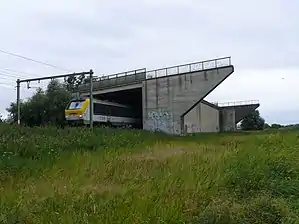Waffle-iron politics
Waffle-iron politics is a Belgian political strategy used in the past for determining the budget for projects in the country's two major regions, Flanders and Wallonia.[2] Under this policy, for every franc spent on a project in Wallonia, a franc was also spent on a similar project in Flanders (and vice versa)[3]
The social and linguistic divisions between Flanders and Wallonia meant that the compromise of waffle-iron politics helped to maintain political peace.[4][5] However, matching spending in one region with equal allocations to the other was costly and inefficient. Waffle-iron politics was a key cause of the Belgian national debt.[6] In 1981, public debt amounted to 130% of GNP, among the highest in the European Community at the time.[7]
Waffle-iron politics also led to the creation of several grote nutteloze bouwwerken (large useless construction works) that were misplaced or unnecessary public use.[8] One example is the bridges in Varsenare, two bridges built in 1976 that were never connected to a highway.[9]
The Dutch word wafelijzerpolitiek literally translates to "waffle-iron politics" or "waffle-iron policy". The name is based on the idea that the waffle-iron always leaves an identical impression on both sides of waffles being baked.[10] Both sides of the iron are necessary in order for the machine to function.

Waffle-iron politics effectively came to an end in 1988 with the third state reform in Belgium. Belgium went from a unitary state to a federal one, giving each region more decision-making power.[11] Flanders and Wallonia became responsible for their own spending, except in matters affecting the entire state.[12]
See also
References
- Lambrechts, Toon. "Lost Highway" (PDF). www.flanderstoday.eu. Retrieved 1 May 2020.
- kld. "Wafelijzerpolitiek". standaard.be. Retrieved 1 May 2020.
- La Libre Belgique (13 June 2003). "La politique du gaufrier". lalibre.be. Retrieved 1 May 2020.
- Van Heffen, Oscar (1999). "Higher education policies and institutional response in Flanders". From the Eye of the Storm. pp. 263–293. doi:10.1007/978-94-015-9263-5_12. ISBN 978-90-481-5355-8.
- Bernheim, Jan (2014). "Questions and Answers on the Belgian Model of Integral End-of-Life Care: Experiment? Prototype?". Journal of Bioethical Inquiry. 11 (4): 507–529. doi:10.1007/s11673-014-9554-z. PMC 4263821. PMID 25124983.
- La Libre Belgique (13 June 2003). "La politique du gaufrier". lalibre.be. Retrieved 1 May 2020.
- De Wit, Kurt & Heffen, Oscar & Verhoeven. "Government, higher education and the national economy: Case study of Flanders". kuleuven.be. Retrieved 1 May 2020.CS1 maint: multiple names: authors list (link)
- Lambrechts, Toon. "Lost Highway" (PDF). www.flanderstoday.eu. Retrieved 1 May 2020.
- "Liste de grands travaux inutiles en Belgique". fr.wikipedia.org. Retrieved 1 May 2020.
- Hooghe, Marc (2009). "From Armed Peace to Permanent Crisis: Cracks in the Belgian Consultative Model". The Low Countries: Arts and Society in Flanders and the Netherlands (17): 227–233. Retrieved 30 Apr 2020.
- Belgian Federal Government (5 June 2013). "The third and fourth State reforms". belgium.be. Retrieved 1 May 2020.
- De Wit, Kurt (1 October 1998). "Case study of Flanders: Government, higher education, and the national economy". Centre for Theoretical Sociology and Sociology of Education - Katholieke Universiteit Leuven: 22. Retrieved 28 Apr 2020.
